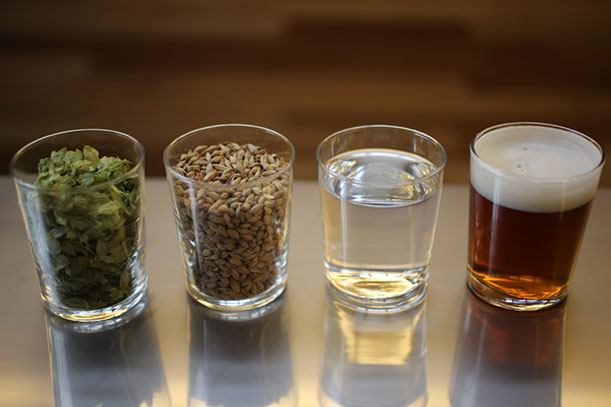Can Brewing Beer Be as Simple as Brewing Coffee?
Inventor Bill Mitchell is developing the PicoBrew Zymatic, an appliance that brews beer at the touch of a button
/https://tf-cmsv2-smithsonianmag-media.s3.amazonaws.com/filer/20131031031104Pico-Brew-beer-brewing-machine-web.jpg)
Bill Mitchell is hoping his new invention will do for beer fans what coffeemakers did for coffee lovers.
While it is a bit larger than even an industrial grade espresso machine and about as expensive, the portable PicoBrew Zymatic beer brewing system still goes a long way toward eliminating much of the tedious and laborious craftsmanship of home brewing. Inside the oven-shaped portable device is an intricate series of computerized precision automation technologies, each doing its part to ensure that even first-time amateurs, with a push of a few buttons, can reliably replicate just about any formula for beer. This month, beer drinkers, who have long clamored for such a dream appliance, pushed the device way past its Kickstarter fundraising goal of $150,000, pledging a total of $661,026.
Even before his 18 years as an engineer and executive at Microsoft, Mitchell had been brainstorming easier ways to make his own beer. During an early experimentation period in college, he recalls testing out a powder mix-based home kit called “Mr. Beer,” one of the few on the market. The resulting concoction, which he describes as nothing to rave about beyond being “technically an alcohol beverage,” served as proof at the time that there weren’t any shortcuts to self-brewing a satisfying mug of high quality beer.
“The best thing about home brewing is that you can create all kinds of flavors,” Mitchell says. ”The combination of ingredients used in beer allows you to make an unlimited number of varieties. Even more so then wine.”
However, the art of home brewing is so painstakingly arduous that only the most dedicated enthusiasts even dabble in do-it-yourself techniques. Hobbyists would have to set aside an entire day, typically referred to as “brew day,” to carry out an eight-hour, labor-intensive process that involves mashing the grain, cooking the barley at the proper temperature to produce the desired sugars and cleaning afterwards. And even with rigorous attention to detail, there is a chance you won’t get the desired result.
“A good way to think about home brewing is that it poses the same challenges common in both chemistry and cooking,” Mitchell explains. “To reliably make a batch according to a particular recipe, the process has to be done close to exact with similar equipment. So not only is it terribly inconvenient and exhausting, it’s very inaccurate.”
But in an age of sensors, robotics and increasingly sophisticated computerization, the PicoBrew Zymatic demonstrates that crafting your own drinks needn’t be so exacting. Granted, while making beer is a much more complex process than, say coffee, the PicoBrew machine condenses the vital parts of brewing down to three to four hours. After downloading a recipe over Wi-Fi, users simply pre-load the water, malted barley and hops into each specified container before pressing “brew.” A computer system controls the entire process and separate software allows users to monitor the beer’s status from any device. Once the 2 1/2 gallon keg of unfermented beer is ready, it only needs to be cooled and have yeast added to complete the process, which takes about a week. Each component was designed to be modular so that it easily fits in a dishwasher, to boot.
The PicoBrew’s finely-engineered DNA came together by combining Mitchell’s computer expertise and his brother Jim’s experience in food processing with hardware architect and former colleague Avi Geiger’s background in machinery. Still, it took three years, several prototypes and a bit of re-inventing the wheel to develop a system that doesn’t mess up each delicate task. For instance, one of the team’s major breakthroughs was re-configuring the machine so that the boiled water would be added to the barley instead of the other way around, which is the way it’s typically done.
“Figuring out how to apply existing technology to a device to make it useful was something I’ve worked with throughout my career,” Mitchell notes. “But this required that we completely re-think many aspects of brewing.”
But as every beer drinker knows, the ultimate litmus test is whether the beer tastes good. To that end, Mitchell has invited everyone who’s curious or skeptical to drop by the company’s office in Seattle to watch it in action and sample a few batches. To bolster his claims, Mitchell entered a couple batches of their machine-made beer in the latest XBrew competition, held by the Washington Homebrewers Association, where he says both won awards. He also points out while the device is appealing for home beers, it can also be immensely useful for larger breweries who often like to test out small batches of a new recipe before moving ahead with large scale production.
“For the longest time, great tasting craft beer was a very inconvenient proposition compared to coffee, which most people brew at home,” Mitchell adds. “With this, I’m thinking people will eventually start treating beer the way they do coffee.”
/https://tf-cmsv2-smithsonianmag-media.s3.amazonaws.com/accounts/headshot/tuan-nguyen.jpg)



/https://tf-cmsv2-smithsonianmag-media.s3.amazonaws.com/accounts/headshot/tuan-nguyen.jpg)